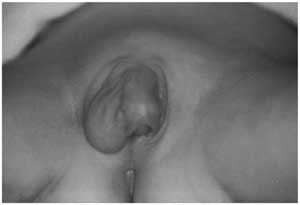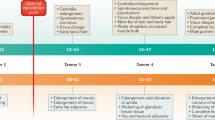Abstract
In recent years, traditional views regarding the management of infants with intersex conditions have been challenged. Some of these patients have gender dysphoria and gender conversion, although most adults with intersex consider themselves to be either male or female. Hormonal and genetic factors may have a more important role in gender identity and sexual satisfaction than previously recognized, whereas the importance of phallus size to male gender identity and sexual satisfaction may have been overestimated. The impact of androgen imprinting on the developing brain is uncertain, but it is likely to be significant. The issue of genital surgery in infancy is controversial, although many adult patients concur that infancy is the best time for such procedures. Several reports indicate that the functional outcomes of genital surgery are poor, although more recently developed surgical techniques may achieve better results. Good communication between physicians, patients, and families regarding intersex conditions is paramount. We review current understanding of the evaluation and management of intersex conditions.
This is a preview of subscription content, access via your institution
Access options
Subscribe to this journal
Receive 12 print issues and online access
$209.00 per year
only $17.42 per issue
Buy this article
- Purchase on Springer Link
- Instant access to full article PDF
Prices may be subject to local taxes which are calculated during checkout



Similar content being viewed by others
References
Miller WL (1988) Molecular biology of steroid hormone synthesis. Endocr Rev 9: 292–318
McPhaul MJ and Griffin JE (1999) Male pseudohermaphroditism caused by mutations of the human androgen receptor. J Clin Endocrinol Metab 84: 3435–3441
Forest MG (2001) Ambiguous genitalia/Intersex: Endocrine aspects. In Pediatric Urology, 623–658 (Eds Gearhart JP, Rink RC, Mouriquand PDE). Philadelphia: WB Saunders
Therrell BL Jr et al. (1998) Results of screening 1.9 million Texas newborns for 21-hydroxylase-deficient congenital adrenal hyperplasia. Pediatrics 101: 583–590
Kappy MS et al. (1994) The Diagnosis and Treatment of Endocrine Disorders in Childhood and Adolescence, edn 4, 573–715. Springfield, IL: Charles C Thomas Publishers Ltd
Rajfer J and Walsh PC (1976) The incidence of intersexuality in patients with hypospadias and cryptorchidism. J Urol 116: 769–770
Kaefer M et al. (1999) The incidence of intersexuality in children with cryptorchidism and hypospadias: stratification based on gonadal palpability and meatal position. J Urol 162: 1003–1006
Nicolino M et al. (2004) Clinical and biological assessments of the undervirilized male. BJU Int 93 (Suppl 3): 20–25
Haqq CM and Donahoe PK (1998) Regulation of sexual dimorphism in mammals. Physiol Rev 78: 1–33
Quigley CA (2001) Genetic basis of sex determination and sex differentiation. In Endocrinology, 1926–1946 (Eds Degroot LJ and Jameson JL). Philadelphia: WB Saunders
Lee MM et al. (2003) MIS/AMH in the assessment of cryptorchidism and intersex conditions. Mol Cell Endocrinol 211: 91–98
Wright NB et al. (1995) Imaging children with ambiguous genitalia and intersex states. Clin Radiol 50: 823–829
Secaf E et al. (1994) Role of MRI in the evaluation of ambiguous genitalia. Pediatr Radiol 24: 231–235
Economy KE et al. (2002) A comparison of MRI and laparoscopy in detecting pelvic structures in cases of vaginal agenesis. J Pediatr Adolesc Gynecol 15: 101–104
Greaves R et al. (2004) Genital abnormalities mimicking congenital adrenal hyperplasia in premature infants. J Paediatr Child Health 40: 233–236
Money J et al. (1957) Imprinting and the establishment of gender role. Arch Neurol Psychiatr 77: 333–336
Zucker KJ (2002) Evaluation of sex- and gender-assignment decisions in patients with physical intersex conditions: a methodological and statistical note. J Sex Marital Ther 28: 269–274
Money J and Ehrhardt AA (1972) Man and Woman, Boy and Girl: Differentiation and Dimorphism of Gender Identity from Conception to Maturity. Baltimore: Johns Hopkins University Press
Diamond M (1999) Pediatric management of ambiguous and traumatized genitalia. J Urol 162: 1021–1028
Chase C (1999) Rethinking treatment for ambiguous genitalia. Pediatr Nurs 25: 451–455
Aaronson I (2004) RE: Attitudes of adult 46, XY intersex persons to clinical management policies. J Urol 171: 1619
Chase C (2002) What is the agenda of the intersex patient advocacy movement? Endocrinologist 13: 240–242
Eugster EA (2004) Reality vs recommendations in the care of infants with intersex conditions. Arch Pediatr Adolesc Med 158: 428–429
Gourlay WA et al. (1994) Gonadal tumors in disorders of sexual differentiation. Urology 43: 537–540
Krasna IH et al. (1992) Risk of malignancy in bilateral streak gonads: the role of the Y chromosome. J Pediatr Surg 27: 1376–1380
Imperato-McGinley J et al. (1979) Androgens and the evolution of male-gender identity among male pseudohermaphrodites with 5alpha-reductase deficiency. N Engl J Med 300: 1233–1237
Mendonca BB et al. (1996) Male pseudohermaphroditism due to steroid 5alpha-reductase 2 deficiency. Diagnosis, psychological evaluation, and management. Medicine 75: 64–76
Odame I et al. (1992) Early diagnosis and management of 5 alpha-reductase deficiency. Arch Dis Child 67: 720–723
Migeon CJ et al. (2002) 46,XY intersex individuals: phenotypic and etiologic classification, knowledge of condition, and satisfaction with knowledge in adulthood. Pediatrics 110: e32
Schober JM (2001) Sexual behaviors, sexual orientation and gender identity in adult intersexuals: a pilot study. J Urol 165: 2350–2353
Hines M et al. (2004) Androgen and psychosexual development: core gender identity, sexual orientation and recalled childhood gender role behavior in women and men with congenital adrenal hyperplasia (CAH). J Sex Res 41: 75–81
Meyer-Bahlburg HF et al. (2004) Prenatal androgenization affects gender-related behavior but not gender identity in 5-12-year-old girls with congenital adrenal hyperplasia. Arch Sex Behav 33: 97–104
Reiner WG and Gearhart JP (2004) Discordant sexual identity in some genetic males with cloacal exstrophy assigned to female sex at birth. N Engl J Med 350: 333–341
Meyer-Bahlburg HF et al. (2004) Attitudes of adult 46, XY intersex persons to clinical management policies. J Urol 171: 1615–1619
Wisniewski AB et al. (2000) Complete androgen insensitivity syndrome: long-term medical, surgical, and psychosexual outcome. J Clin Endocrinol Metab 85: 2664–2669
Migeon CJ et al. (2002) Ambiguous genitalia with perineoscrotal hypospadias in 46,XY individuals: long-term medical, surgical, and psychosexual outcome. Pediatrics 110: e31
Wisniewski AB and Migeon CJ (2002) Long-term perspectives for 46,XY patients affected by complete androgen insensitivity syndrome or congenital micropenis. Semin Reprod Med 20: 297–304
Reilly JM and Woodhouse CR (1989) Small penis and the male sexual role. J Urol. 142: 569–571
Crouch NS et al. (2004) Genital sensation after feminizing genitoplasty for congenital adrenal hyperplasia: a pilot study. BJU Int 93: 135–138
Creighton SM et al. (2001) Objective cosmetic and anatomical outcomes at adolescence of feminising surgery for ambiguous genitalia done in childhood. Lancet 358: 124–125
Minto CL et al. (2003) The effect of clitoral surgery on sexual outcome in individuals who have intersex conditions with ambiguous genitalia: a cross-sectional study. Lancet 361: 1252–1257
Gearhart JP et al. (1995) Measurement of pudendal evoked potentials during feminizing genitoplasty: technique and applications. J Urol 153: 486–487
Minto CL et al. (2003) Sexual function in women with complete androgen insensitivity syndrome. Fertil Steril 80: 157–164
Author information
Authors and Affiliations
Corresponding author
Ethics declarations
Competing interests
The authors receive funding and research support from Cook Urological, ACMI Corporation and Boston Scientific Corporation.
Rights and permissions
About this article
Cite this article
Nelson, C., Gearhart, J. Current views on evaluation, management, and gender assignment of the intersex infant. Nat Rev Urol 1, 38–43 (2004). https://doi.org/10.1038/ncpuro0028
Received:
Accepted:
Issue Date:
DOI: https://doi.org/10.1038/ncpuro0028
This article is cited by
-
Disorders of sex development in a developing country: perspectives and outcome of surgical management of 39 cases
Pediatric Surgery International (2015)
-
The biology of infertility: research advances and clinical challenges
Nature Medicine (2008)


